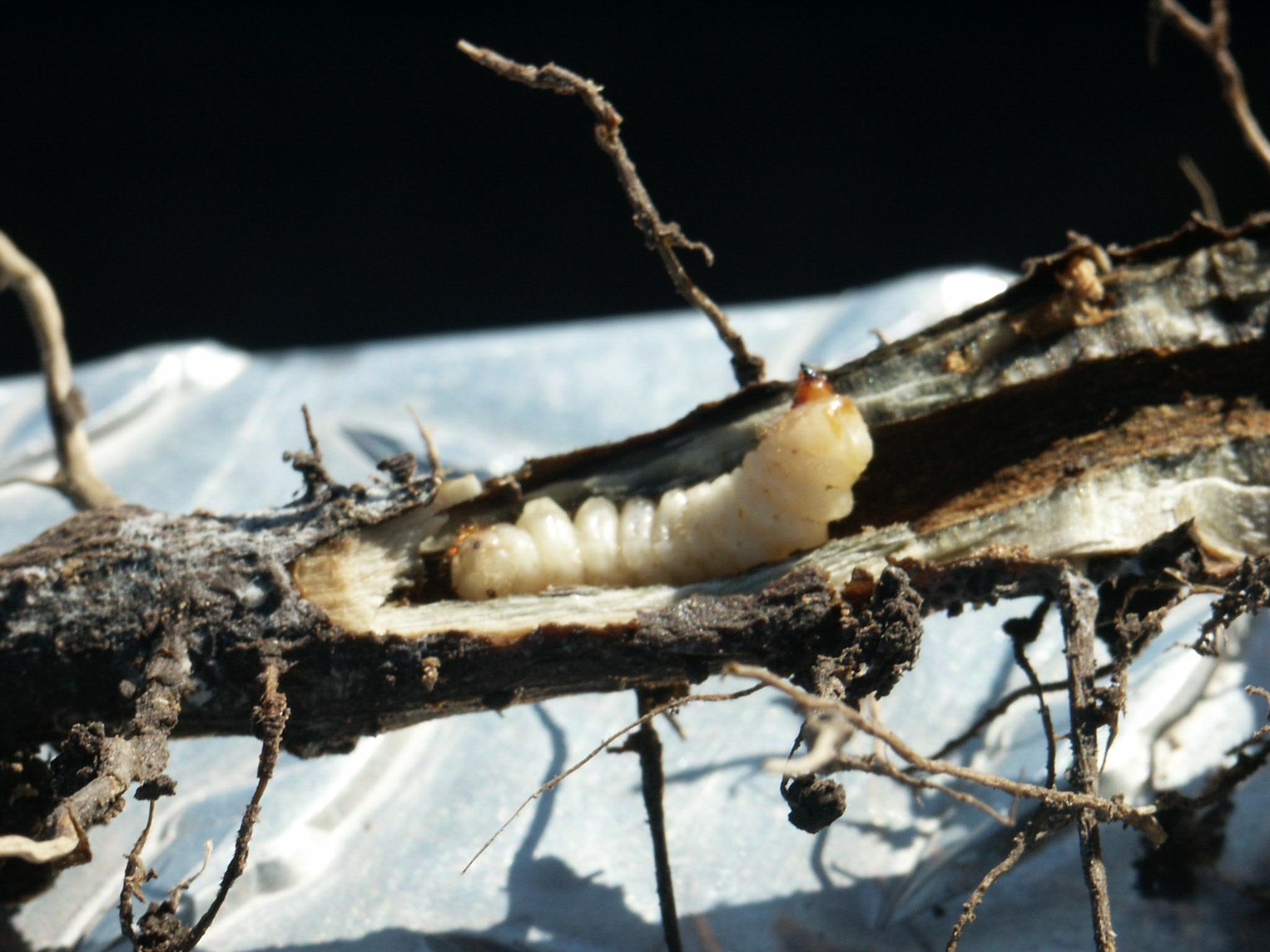Sunflower Insects
The longhorned borer Ataxia hubbardi (Coleoptera: Cerambycidae)

Adult of Ataxia hubbardi
(Photo credit: J.P. Michaud)

Larva of Ataxia hubbardi (note blunt posterior with bristles)
(Photo credit: J.P. Michaud)

During warm winter days, larvae of Ataxia hubbardi will feed in above-ground portions of the stalk, but they descend to the plant roots during cold weather, as this one has.
(Photo credit: J.P. Michaud)
Identification
This longhorned beetle shares many composite host plants with D. texanus, including cultivated sunflower, but larvae do not girdle and therefore do not cause the same crop losses. Adults average 2.0 - 3.0 cm (3/4 - 1 ¼ inches) in length, three times the size of adult D. texanus, and are brown rather than bluish grey. They are very cryptic in behavior and difficult to observe in the field without knowledge of their habits. Adults girdle leaf petioles and then hide within the dried up leaf that is left hanging from the plant. Upon exposure, they are typically very quiescent and inactive, although they will scramble around quickly and tumble to the ground when prodded. The large, curved eggs are laid just under the epidermis of plant petioles in a rather hap-hazard manner, often leaving a visible sub-epidermal swelling and sometimes partially protruding from the plant. Although the larvae superficially resemble those of D. texanus, the deeply-indented segments are not tapered but end in a very blunt posterior segment covered with large bristles.
Life History and Behavior
Ataxia hubbardi has a similar life cycle to that of D. texanus with only one generation per year, although adults tend to emerge a week or two earlier in the spring and are much longer-lived in the laboratory. The eggs are relatively resistant to desiccation and readily hatch outside of plant tissue. As a larva, A. hubbardi is a formidable competitor with D. texanus because of its greater size and very aggressive nature. Larvae do not enter a dormant state during winter months but remain actively feeding, growing and molting, often hollowing out the stalk completely, and moving down to the roots during cold periods. Small larvae readily feed and grow when provided only dry sunflower pith in the laboratory, so stalk desiccation does not represent the end of their food supply as it does for D. texanus larvae. Girdling is not performed by larvae in the fall, most likely because it would eliminate the winter food supply before growth and development have been completed. Although larvae of D. texanus are extremely rare in wild sunflowers in Kansas, those of A. hubbardi are often quite common. Very often a single plant will host multiple A. hubbardi larvae – one large primary larva that dominates the main stalk, and a series of much smaller ones that remain confined to the upper branches where they are presumably safe from attack by the primary. It is unlikely that many, if any, of these secondary larvae survive to adulthood, but one may have opportunity to do so if the primary larva perishes and yields the main stem.
In cultivated sunflowers, and especially in confectionary varieties, A. hubbardi sometimes predominate over D. texanus in very early plantings, although the reason for this is not understood. Adults appear longer-lived than D. texanus in the laboratory, making the apparent absence of larvae in later plantings difficult to explain. Ocassionally, stalks with both A. hubbardi and D. texanus larvae can be found, usually with the D. texanus larva in a sealed chamber below the A. hubbardi larva. Although D. texanus appears to sustain its populations mostly within cultivated crops, A. hubbardi still utilizes wild host plants primarily and can be very abundant in wild H. annuus and cocklebur, Xanthium strumarium, both plants thought to be among the ancestral host plants of D. texanus. Ataxia does not attack soybean, so for D. texanus this novel host plant may represent a refuge from an intense competitor.
Management
There is no evidence that sunflower production is negatively impacted by A. hubbardi infestation, or that specific management tactics against it are warranted. Rather, it is important for growers to recognize larvae of this species so that they are not mistaken for those of D. texanus that represent a greater agronomic concern. Foliar materials applied for control of stem weevils usually provide simultaneous control of A. hubbardi as adults are active early in the season, but seed treatments do not provide control.
Author: J.P. Michaud, Associate Professor of Entomology
Page last updated 09/19/2013 by J.P. Michaud.